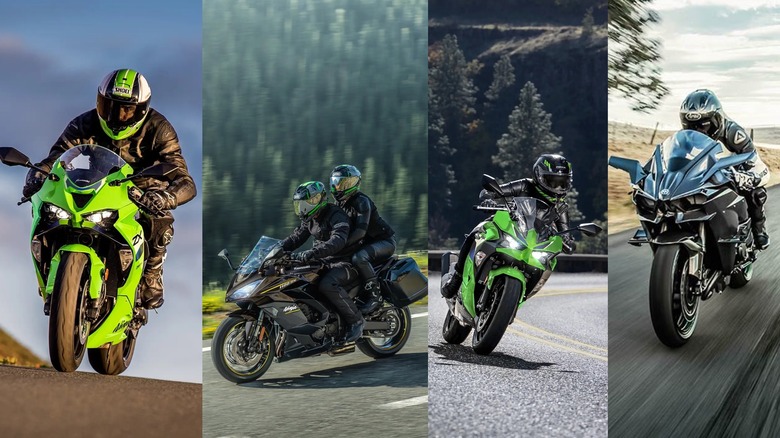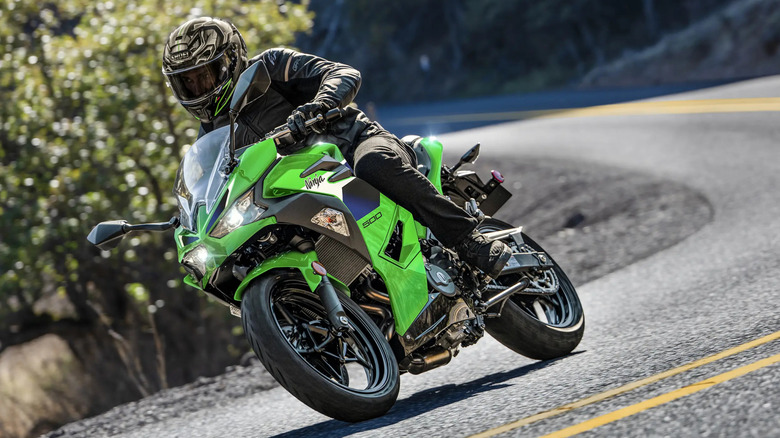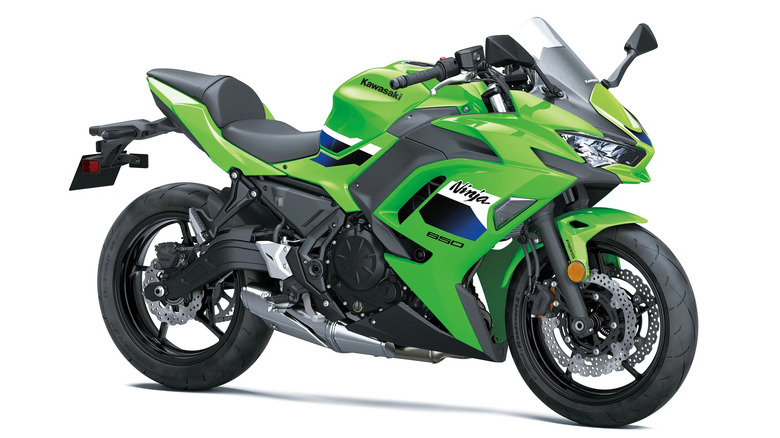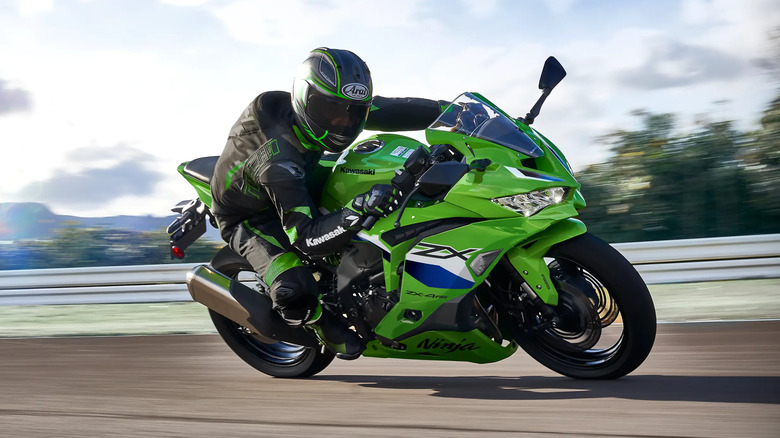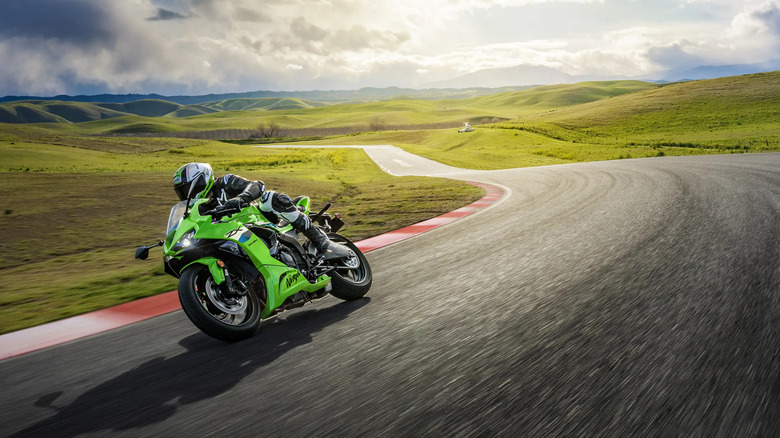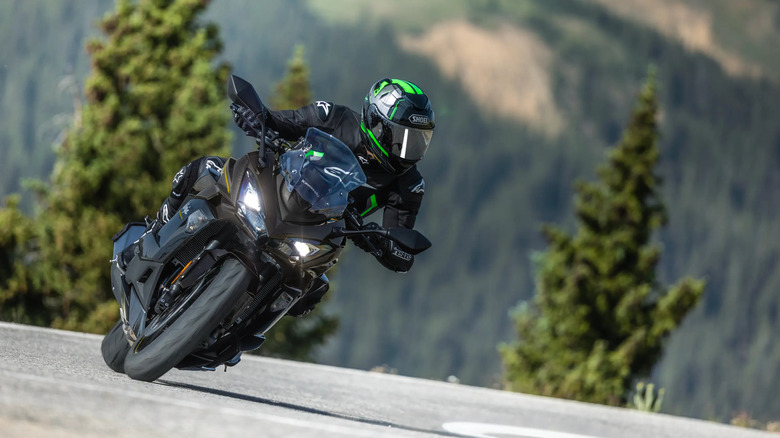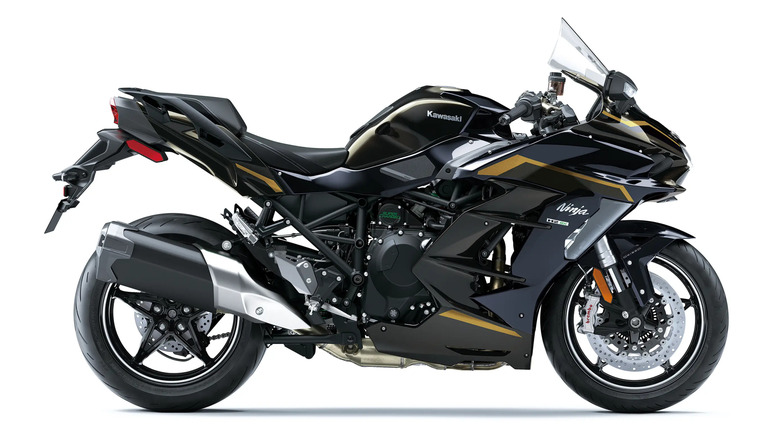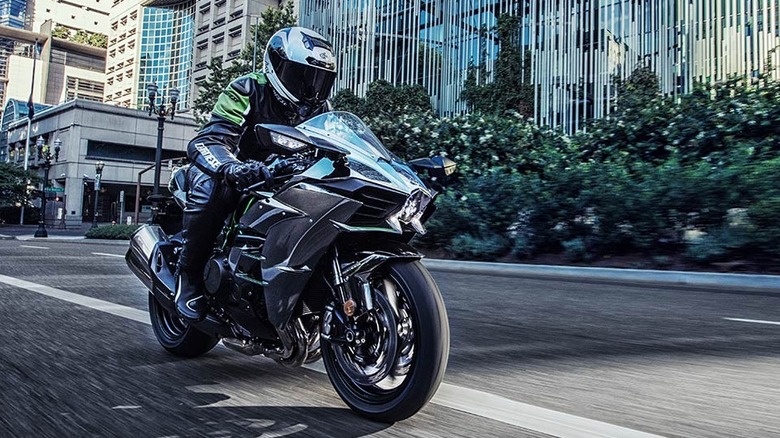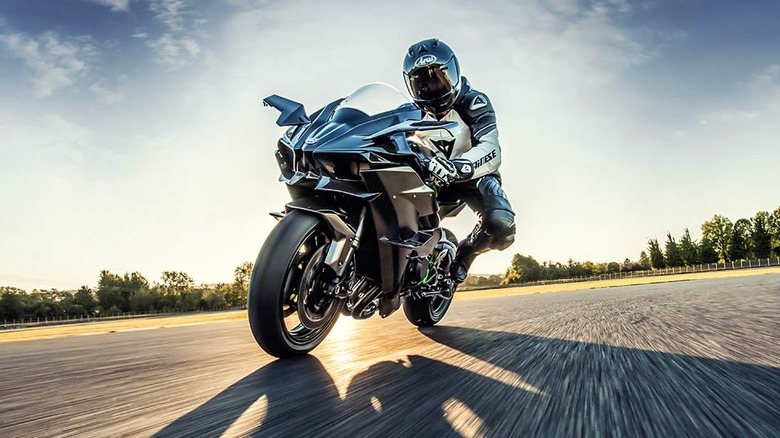Every Kawasaki Ninja Model Confirmed For 2026 So Far, Ranked By Price
As we round the corner of 2025 and see the new year in the distance, manufacturers are rolling out the details and the prices on their newest models and Kawasaki is in on the game pretty early, with lots of prices now available for 2026. The original Ninja was one of the coolest looking Kawasaki bikes of all time, and these days name covers 13 different models across three different classes of sportbike. That's a lot of sporty green motorcycles. Kawasaki divides them up into subcategories too, helping shoppers get a sense for a bikes purpose and capacity for speed: Sport, Supersport, and Hypersport.
Motorcycle manufacturers often debut new colors, new features, and various updates with model-year change overs and Kawasaki has done that on several of its Ninja models. With those changes, though, (and in some cases with no changes at all) come some new prices too. In some instances, the prices have gone up by as little as $100 year-to-year, but in other cases they've gone up by thousands. Here's what's been priced so far, for 2026.
Ninja 500 — $6,049
The least expensive Ninja that Kawasaki currently offers is the 500, and it's one of the best bikes the brand makes for city riding. It comes in a number of different trim levels, but we're basing the ranking of this list on the lowest price possible in the lineup, so we'll start there. MSRP for the standard 2026 Ninja 500 without ABS (anti-lock brakes) is as low as $6,049 (including $650 destination fee) — a $100 increase over last year's price. Adding ABS brings the price up by $400. Higher spec versions of the 500 known as the SE checks in at $7,149, adding a bit more tech and unique styling, as well as ABS included in the package. The SE's added features include a USB outlet, a TFT rider screen, frame sliders, tank and knee pads for added comfort, and a radiator screen to keep bugs out.
The Ninja 500 shares a lot of its styling with larger and more powerful Ninja bikes, but the 500 is a relatively approachable sport bike for beginner riders. Upgrading from a small 250-300cc bike? This is probably a pretty good sweet spot for you. The Ninja 500 is powered by a 451cc parallel-twin engine connected to a six-speed manual transmission. The parallel twin produces 51 hp and 31.7 lb-ft of torque. That's enough for some sporty riding, but not so much that it'll feel uncontrollable right out of the box. The 500 is relatively lightweight too. At just 377 pounds for the ABS model, it should be relatively easy to maneuver through tight corners.
Ninja 650 — $8,284
Like the smaller 500, the Ninja 650 provides proper sportbike styling at an affordable price and reasonable power. It's not a sky-high-revving superbike, but it's modern and has a respectable amount of features. Like the 500, the Ninja 650 is available in two main trims: one without ABS, one with it. The non-ABS version has a starting price of $8,284 and ABS will cost you another $600. Those are both $200 increases over the 2025 model year.
Power for the Ninja 650 is provided via a 649cc parallel-twin engine. Don't let the Ninja 650's displacement fool you, though. It's not faster or more powerful than bikes with smaller displacement like the 636cc ZX-6R (more on that in a bit). The Ninja 650 is, however, more powerful than the 500. The 650 produces 67 hp and 48.5 lb-ft, which are both considerable advantages in power with a relatively small jump in price. Curb weight is noticeably higher at 425 pounds, but that's still adequately light for a sport bike with the Ninja 650's performance levels. You get the extra power with the Ninja 650, but not much more in the way of added features — there's no quick shifter or cruise control here. The 650 does however, get dual front brake calipers for some additional stopping power (the 500 only has a single caliper), and slightly wider tires for a bit more traction and performance.
Ninja ZX-4R — $9,949
At this point, it's time to move on to the supersport category, where a decrease in engine displacement may seem like a step back, but it certainly isn't. The Ninja ZX-4R may be small, but it uses a high-revving 399cc inline four-cylinder engine that produces impressive power for its size: 56 hp and 26.2 lb-ft of torque. And that's not the limit for power either. Tuners and owners have been modifying the ZX-4R for years, with lots of performance increase via small changes. Some tuners show power increases as high as 76 hp with minor modifications to the ECU and exhaust.
Most motorcycles in the 400-500cc range these days are parallel twins, but the ZX-4R (and it's ZX-4RR trim level) sets itself apart with its four-cylinder engine that makes it feel a bit more like a proper track bike. It reaches its peak horsepower number at 11,500 rpm, which is 3,500 rpm higher than the Ninja 650 with its parallel twin. Like some of the more-expensive bikes in Kawasaki's Ninja lineup, the ZX-4R offers adjustable power modes, traction control, and Showa suspension.
The standard 2026 ZX-4R has an MSRP of $9,949, which represents a $300 increase from the previous model year, while the upgraded ZX-4RR will run you $10,649 (also a $300 increase from the previous year). For that extra money, the RR version comes standard with upgraded suspension and a quick shifter that makes it a bit more enjoyable to ride on the track or on the street.
Ninja ZX-6R — $12,284
If you're good at pattern recognition, the next bike's increased power and performance for more money than the previous bikes won't be a big surprise to you. Kawasaki has a pretty easy-to-follow pricing structure for its Ninja bikes and just above the ZX-4R, there's the faster and more powerful (but also more expensive ZX-6R. The Ninja ZX-6R is highly competitive in its class, going up against bikes like the Honda CBR600RR, but providing more displacement and power. The ZX-6R uses a 636cc inline four-cylinder engine that produces a screaming 127 hp and 52.1 lb-ft. At this point in the Kawasaki lineup, features like a quick shifter and a 4.3-inch rider display come standard, but you still have the choice of whether or not you'd like ABS.
The standard 2026 ZX-6R without ABS has an MSRP of $12,284. ABS models add $1,000 to that price tag. Both prices represent a $200 increase over last year's model. That price comes with a good amount of suspension adjustability to go along with the ZX-6R's power, including rebound and compression damping, and spring preload adjustability up front and the rear. There's no double-R version of the ZX-6R like there is with the smaller ZX-4RR (or even the bigger ZX-10R) but there's still plenty of performance to be had via Pirelli Diablo Rosso IV tires and big four-piston front brakes. Like pretty much all the ZX-coded Ninja bikes, the ZX-6R is about as track-ready as they come on day one.
Ninja 1100SX — $14,839
Venturing into the comfortable sport cruiser territory, the next bike on our list is the 2026 Ninja 1100SX. SX, in Kawasaki the world, is the stamp put on bikes that are designed a bit more with comfort and long-distance riding in mind, but they're still plenty powerful and entertaining to ride. The aptly-named, comfortable but powerful 1100SX is powered by a 1,099cc four-cylinder engine that produces 134 hp and 83.2 lb-ft of torque. Compared to smaller four-cylinder bikes like the ZX-6R, the 1100SX's torque is pretty impressive. Delivery of the extra torque happens down low in the rev range, making it good at city commuting as well as highway passes when you're in top gear.
Electronic rider aids include cruise control, traction control, multiple power modes, and Kawasaki's cornering management system. A quick shifter is naturally standard on a bike oriented for comfort like the 1100SX, as is a 4.3-inch rider display, a USB-C charging port, smartphone connectivity and Kawasaki's Rideology app. With an MSRP of $14,839, the 1100SX is only marginally more expensive than the ZX-6R, (and only $300 more than last year's model) but the 1100SX has a more upright riding position, more creature comforts, and a big increase in torque, all of which make it more enjoyable to ride over long distances. It's also a better commuter, even if it does lack the high-revving joy provided by the ZX-6R.
Ninja H2 SX SE — $30,839
If you want the crown jewel engine of Kawasaki's lineup, but you want to save as much money as possible while making the purchase, the H2 SX might be the right choice for you. Essentially, it's a superbike that you can take on just about any journey where there's a road. The crown jewel in question is the 998cc inline four-cylinder engine that's big enough on its own to provide impressive power, but Kawasaki adds a supercharger to the mix. That's what powers the H2 SX. Like the 1100SX, the Ninja H2 SX is a sport touring bike, but it has significantly more power.
The engine/supercharger combination makes for an incredible 207 hp and 101 lb-ft of torque. Going beyond the power provided by most naturally-aspirated supersport bikes (which is the norm really), the Hypersport classification for the H2 SX is truly fitting. On top of all that power, the H2 SX SE offers advanced creature comforts like adaptive cruise control, blind-spot monitoring, forward collision warning and a large 6.5-inch rider display. It also has all the performance pieces you'd expect like Showa forks/shocks, electronically-adjustable suspension settings, and Brembo brakes. You'll pay for the privilege of power and comfort combined in one machine though. The 2026 H2 SX has an MSRP of $30,839, an $899 price increase from the 2025 model.
Ninja H2 — $35,340
Like the H2 SX, the H2 uses Kawasaki's supercharged four-cylinder engine, but in this case it's offering 240 hp and 104.9 lb-ft of torque. That's not just more than most 1,000cc motorcycles, that's more than most compact hatchbacks or sedans. The H2 manages its power with a series of high-tech rider aids like Kawasaki's nine-mode traction control system, launch control, intelligent anti-lock brakes, and Bosch IMU (inertial measurement unit) that tracks the bike's movements across six axes to control the various rider aids. Suspension components include an Öhlins shock in the rear and fully adjustable front suspension, paired with four-piston Brembo Stylema calipers to handle the braking from high speeds.
The standard H2 (there are a few other versions available) comes in two trims: the standard and the H2 Carbon. The standard H2 model has all the features listed above and some other items worth noting like Bridgestone Battlax RS11 tires, a bi-directional quick shifter, and a TFT rider display. The price for all this power, performance, and equipment? The H2 starts at $35,340. Upgrade to the H2 Carbon with its carbon fiber upper cowl, and it'll cost you $38,940. Not only is the H2 more powerful than most economical hatchbacks, it's more expensive too.
Ninja H2R — $62,940
The power provided by the H2R rises to historic levels, even higher than the standard H2. With a unique compression ratio and its own tuning, the H2R puts out 322 hp and 121 lb-ft of torque. Those are the sort of numbers that put it head and shoulders above even the most powerful liter bikes from within Kawasaki's own lineup and from just about every other manufacturer. Those numbers are also part of why it's a track-only bike. Few bikes offer the performance bonafides that the H2R does, which is part of why it's so expensive.
Every year, Kawasaki releases the H2R for a limited time, so depending on when you're reading this, every model may already be reserved — by October 31st 2025, Kawasaki will stop taking orders and they'll all be spoken for, unless you go shopping on the used market. Pricing for the H2R has changed significantly for 2026, with the new model now costing $62,940. That's $3,000 more than the 2025 model year bike. Thankfully though, that's the only version of the bike you can get — there's no upgraded model with extra equipment. The H2R comes with everything you'll need to win spec-sheet races and, if you've got the talent to harness its power, plenty of real-world races as well.
